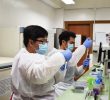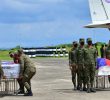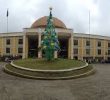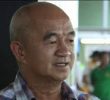By GINGGING AVELLANOSA- VALLE
Davao Today
Relief assistance for people displaced by the fighting between the government and the Moro Islamic Liberation Front in Maguindanao has come to a halt after the massacre that killed 58 people, 32 of them journalists, in the town of Ampatuan on November 23 last year.
Jesse C. Agbulos, the program coordinator of Kutawato Coalition of Development NGOs (KCODE), said relief efforts by KCODE and other affiliate groups have been at a standstill after the massacre.
He said relief NGOs barely finished distributing relief assistance to thousands of Maguindanao residents affected by the internal strife a few months before the massacre when they were faced again with a more daunting situation.
Agbulos said their work for the “eradication of the root causes of poverty,” which is KCODE’s main thrust, has suffered a major setback owing to the current situation in Maguindanao.

A woman evacuee receives her share during the relief goods distribution of KCODE.
He described the situation in the province as one that warrants a tough nerve. He admitted that the presence of the military lends an “air of safety” to the troubled areas but he cautioned that the peace and quiet is still “very fragile.”
KCODE, a group of civil society organizations in Maguindanao closely monitoring and assisting internally displaced persons (IDPs), has been in the thick of relief efforts with other relief NGOs since the middle of 2008 because of the series of skirmishes between the MILF and the Armed Forces of the Philippines that started in August 2008 in Central Mindanao. The conflict had continued the following year.
Agbulos cited a June 2009 report of the Department of Social Welfare and Development placing at 37,770 the total number of families [189,146 persons] who fled from 109 affected villages and flocked to 146 evacuation centers in the province after rebel forces clashed with the Armed Forces of the Philippines troops.

A floating tent city.
The massive displacement moved KCODE and other relief organizations like the Lutheran World Relief (LWR), the Peace and Equity Foundation and the International Office for Migrants (IOM) to facilitate the distribution of food items, health kits, quilts, layettes and other non food items (including latrines) to selected evacuation centers in response to the basic needs earlier expressed by the IDPs.
Sometime in September 2009, another wave of IDPs trooped to evacuation centers in Maguindanao and stayed there for an indefinite period.
The ground assaults and aerial bombings caused the exodus of families away from their houses. Hundreds of houses were either hit by bombs or were damaged beyond repair; livestock, farm crops, properties and belongings, destroyed; and an undetermined number of civilians, killed and wounded.
The IDPs mainly came from the towns of Datu Saudi Ampatuan, Guindulungan, Datu Anggal Midtimbang, Ampatuan, So. Kabuntalan,Talayan, and Datu Odin Sinsuat.
Lately, some of these municipalities were reported to have been affected by massive evacuation after an emergency situation was imposed in Maguindanao.
Poverty









